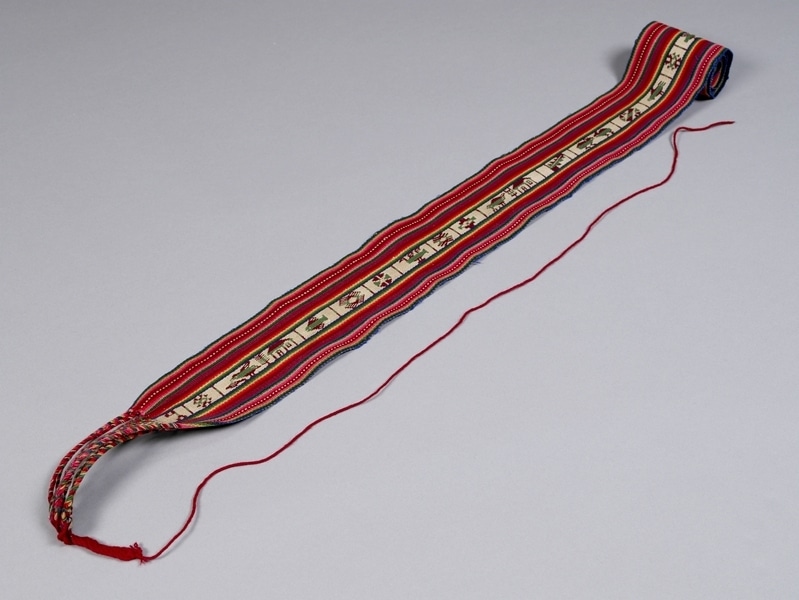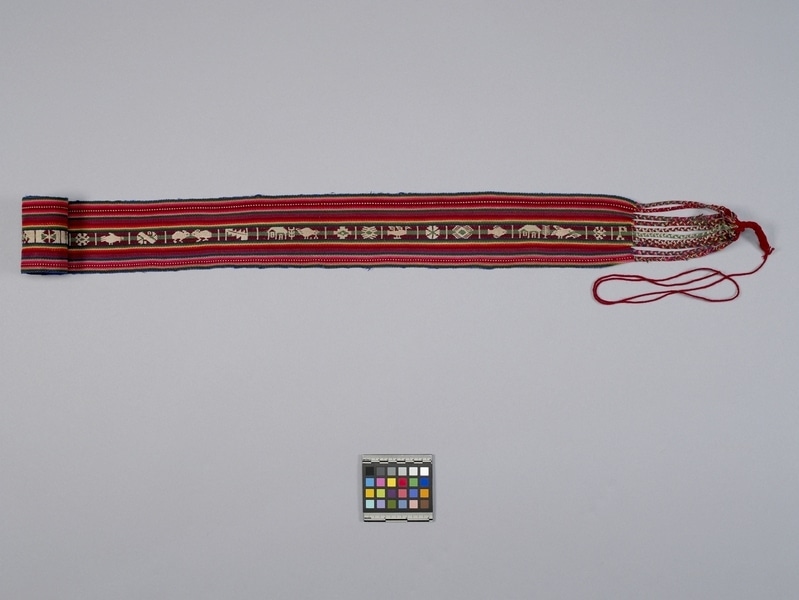Belt Item Number: Sf1005 from the MOA: University of British Columbia


Description
Long belt with lengthwise stripes in multiple colours and a central design band with white animal, fish, bird, flower and building motif,s on a dark red and green background. One end terminates in ten braids which are looped together by a separate cord and attached to another cord tie. The other end of the belt has similar cords attached to the selvedge. Two narrow white stripes on multi-colour striped bands at edges.
History Of Use
The techniques, structures and some of the motifs have pre-Conquest antecedents. This type of textile conveys the most about an individual's ethnicity, sex, age, status and particular history. Wide belts are used by women during pregnancy and after having a baby. They believed, a tightly bound belt keeps the baby from growing too large and making the birth difficult. After the birth, the belt supports weakened midriff muscles. Women's belts are also used to hold the swaddling cloths around babies, both male and female. This is the only instance where a belt of this type is used by a male. Women also wear belts on a daily basis when not pregnant.
Cultural Context
Pregnancy
Narrative
Nancy wove this for her own use, in 1985, when she was pregnant. She bound it tightly above the baby to keep the baby's head from getting too large and making the birth difficult. She also wore it after the birth when her muscles were weak and she used it occasionally to swaddle the baby.
Specific Techniques
Commercial synthetic yarns, z spun and plied 2-s are retwisted before warping. The colour stripes are warp faced plain weave and the design band is double cloth plain weave with pick-up designs. The braided ends are 3 strand oblique interlacing and the cords are z spun, s plied and z replied. The fabric is one loom piece uncut. It has three selvedges and the terminal area is braided.
Iconographic Meaning
The range of motifs refers to local geography and landmarks, ecology, fecundity as well as luck. The six part circle refers to the division of land into six sections on Taquile and the rotation of crops and fallow periods. The motifs starting at the selvedge are: 'vaca' (cow); 'karachi' (species of fish); 'pichitanka' (species of bird); an altar; 'chiwako' (a bird that eats the crops); 'wasi' and 'k'olle' (house and species of tree; the thatch on the roof is ruined); 'conejo' (rabbit or guinea pig); an altar; pair of 'pichitanka' (birds); 'bandera' (a dance with flags); 'pisqo' (species of bird); 'rosa silla' (rose with thorns); 'conejo' (pair of guinea pigs); 'cinta lawar' (stepped path); 'wasi', 'k'olle' and 'wallpa' (house, tree and chicken); bowl to hold edible clay; 'chaska' (star); 'pato' (duck); 'tejeral' (scissors); 'karachi' (fish); 'wasi' 'k'olle' and 'picaflora' (house, tree and humming bird; and, 'bandera' (dance with flags for 24th of June fiesta).
Item History
- Made by Nancy Machaca Quispe (Maker) in Taquile, Puno, Peru during 1985
- Collected by Mary Frame during 1987
- Owned by Mary Frame before November 3, 1987
- Received from Mary Frame (Seller) and Museum of Anthropology Shop Volunteers (Funding source) on November 3, 1987
What
- Name
- Belt
- Identification Number
- Sf1005
- Type of Item
- belt
- Material
- synthetic fibre
- Manufacturing Technique
- retwisted, woven and braided
- Overall
- height 8.8 cm, width 139.0 cm
Who
- Culture
- Quechua
- Creator
- Nancy Machaca Quispe (Maker)
- Field Collector
- Mary Frame
- Previous Owner
- Mary Frame
- Received from
- Mary Frame (Seller) and Museum of Anthropology Shop Volunteers (Funding source)
Where
- Holding Institution
- MOA: University of British Columbia
- Made in
- Taquile, Puno, Peru
When
- Creation Date
- during 1985
- Collection Date
- during 1987
- Ownership Date
- before November 3, 1987
- Acquisition Date
- on November 3, 1987
Other
- Item Classes
- textiles
- Condition
- good
- Accession Number
- 1274/0028